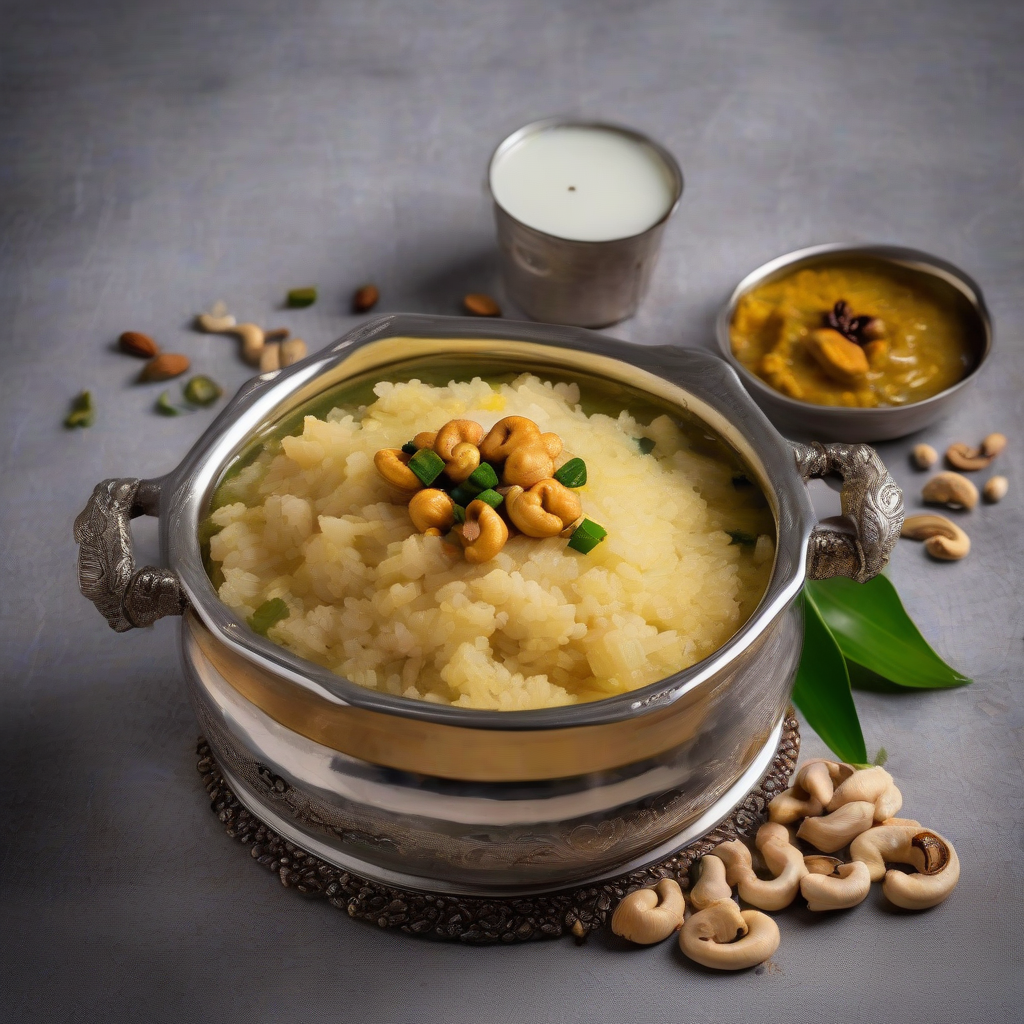Pongal-icious! A Ghee-licious Start to Your Day!
Namaste and Vanakkam, my dear food-loving friends! Chef Curry Do’pyaza here, ready to whisk you away on another culinary adventure! Today, we’re diving headfirst into a South Indian staple, a dish that’s as comforting as a warm hug on a chilly morning: Ven Pongal!
This isn’t just any rice and lentil dish; it’s a celebration of simple flavors, elevated by the magic of ghee, the zing of pepper, and the delightful crunch of cashews.
When do we Pongal?
Pongal isn’t just a dish; it’s an emotion, deeply intertwined with our culture. We make this especially during the Pongal festival, a harvest festival celebrated with great enthusiasm in Tamil Nadu and other parts of South India. It’s a time to thank the sun god for a bountiful harvest, and what better way to do that than with a pot of steaming, fragrant Ven Pongal? It’s also a popular breakfast dish, especially on those lazy weekend mornings when you crave something warm and satisfying. You’ll often find it served in temples as “prasadam” (blessed food), a testament to its auspicious nature.
A Little Pongal History Lesson
Ven Pongal has been around for centuries! Its origins are rooted in the ancient South Indian tradition of offering food to the gods. Over time, it evolved into a beloved breakfast and festive dish, enjoyed by generations. It’s a testament to the resourcefulness of our ancestors, who transformed simple ingredients into a culinary masterpiece.
Let’s Get Cooking!
Preparation Time: 10 minutes
Cooking Time: 30 minutes
The Pongal Pantry (Ingredients):
- 1/2 cup Pachai Arisi (Raw Rice) – Short grain variety is best
- 1/4 cup Moong Dal (Yellow Split Lentils)
- 4 cups Water
- 2 tablespoons Ghee (Clarified Butter) – the more, the merrier!
- 1 teaspoon Jeera (Cumin Seeds)
- 1 teaspoon Kali Mirch (Black Peppercorns) – freshly crushed, please!
- 1/2 inch Adrak (Ginger) – finely grated
- 1/4 cup Kaju (Cashews)
- 1/4 teaspoon Hing (Asafoetida)
- Salt to taste
Pongal Power-Up (Step-by-Step Instructions):
- Roast the Goodness: In a dry pan, gently roast the moong dal until it turns light golden and fragrant. This step adds a nutty depth to the pongal.
- Wash and Soak: Wash the rice and roasted moong dal together until the water runs clear. Soak them in water for about 15-20 minutes. This helps in even cooking and a softer texture.
- Pressure Cook (The Traditional Way): Transfer the soaked rice and dal to a pressure cooker. Add 4 cups of water and a pinch of salt. Close the lid and cook for 3-4 whistles on medium heat. Let the pressure release naturally.
- The Ghee-licious Tempering: While the rice and dal are cooking, prepare the tempering. In a small pan, heat ghee over medium heat.
- Spice It Up: Add cumin seeds. Once they start to splutter, add the crushed peppercorns, grated ginger, asafoetida, and cashews. Fry until the cashews turn golden brown. Be careful not to burn them!
- Pongal Power Activated! Once the pressure is released from the cooker, gently mash the cooked rice and dal with a spoon. It should have a soft, porridge-like consistency. If it’s too thick, add a little hot water to adjust the consistency.
- The Grand Finale: Pour the ghee tempering over the pongal and mix well. The aroma will be simply divine!
- Taste and Adjust: Taste the pongal and add more salt if needed.
Chef’s Secret Pongal Tips:
- Ghee is Key: Don’t skimp on the ghee! It’s what gives the pongal its rich flavor and creamy texture.
- Fresh is Best: Use freshly crushed peppercorns for that extra zing.
- Consistency is King: Adjust the water to achieve your desired consistency. Some prefer a thicker pongal, while others like it more runny.
- Cashew Crunch: Roast the cashews until they are golden brown for a delightful crunch.
Pongal Your Way: Cooking Variations
- Stovetop Method: If you don’t have a pressure cooker, you can cook the rice and dal in a pot on the stovetop. Use a 1:4 ratio of rice+dal to water. Cook on low heat, covered, until the rice and dal are soft and mushy.
- Induction Cooktop: Follow the same instructions as the stovetop method, adjusting the heat settings as needed.
- Slow Cooker/Crockpot: This is a great option for hands-off cooking. Combine all the ingredients in the slow cooker and cook on low for 4-6 hours, or on high for 2-3 hours.
- Microwave: Not recommended as it’s difficult to achieve the right texture.
- Air Fryer: Definitely not for Pongal!
- Oven: While possible, it’s not the most efficient method. You can bake the rice and dal in a covered dish with water, but it will take a long time.
Pongal Nutrition Nuggets (Approximate Values):
- Calories: Approximately 250-300 per serving
- Protein: 8-10 grams
- Carbohydrates: 40-50 grams
- Fat: 10-15 grams (mostly from ghee)
Pongal Presentation & Plating (Serving Suggestions):
- Serve hot, garnished with a dollop of ghee and a sprinkle of freshly chopped coriander leaves.
- Pair it with coconut chutney, sambar, or a spicy tomato chutney for a complete and satisfying meal.
- It’s also delicious on its own!
Your Pongal Adventure Awaits!
So there you have it, my friends! A simple yet soul-satisfying recipe for Ven Pongal that’s sure to become a family favorite. I urge you to try this recipe at home. Share your delicious creation with your friends and family and spread the Pongal love! Happy cooking!
